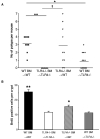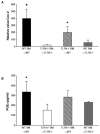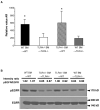Innate immune signaling by Toll-like receptor-4 (TLR4) shapes the inflammatory microenvironment in colitis-associated tumors
- PMID: 19229991
- PMCID: PMC2712657
- DOI: 10.1002/ibd.20880
Innate immune signaling by Toll-like receptor-4 (TLR4) shapes the inflammatory microenvironment in colitis-associated tumors
Abstract
Background: Patients with ulcerative colitis are at increased risk for developing colorectal cancer. We have shown that Toll-like receptor-4 (TLR4) is overexpressed in human colitis-associated cancer (CAC) and that mice deficient in TLR4 are markedly protected against colitis-associated neoplasia. We wished to elucidate the specific contributions of TLR4 signaling by myeloid cells and colonic epithelial cells (CEC) in colitis-associated tumorigenesis.
Methods: TLR4-deficient mice or wildtype littermates (WT) were transplanted with bone marrow (BM) cells: TLR4(-/-) BM-->WT mice (TLR4-expressing CEC) and WT BM-->TLR4(-/-) mice (TLR4-expressing myeloid cells). Colitis-associated neoplasia was induced by azoxymethane (AOM 7.3 mg/kg) injection and 2 cycles of dextran sodium sulfate (DSS) treatment.
Results: The number and size of dysplastic lesions were greater in TLR4(-/-) BM-->WT mice than in WT BM-->TLR4(-/-) mice (P < 0.005). Histologically, TLR4(-/-) BM-->WT mice had greater numbers of mucosal neutrophils and macrophages compared to WT BM-->TLR4(-/-) mice. The chemokines KC and CCL2, important in recruitment of neutrophils and macrophages, respectively, were induced in mice expressing TLR4 in CEC rather than the myeloid compartment. The lamina propria infiltrate of mice expressing TLR4 in CEC was characterized by macrophages expressing Cox-2. Moreover, mice expressing TLR4 in CEC rather than the myeloid compartment had increased production of amphiregulin and EGFR activation.
Conclusions: These findings indicate that TLR4 signaling on CEC is necessary for recruitment and activation of Cox-2-expressing macrophages and increasing the number and size of dysplastic lesions. Our results implicate innate immune signaling on CEC as a key regulator of a tumor-promoting microenvironment.
Figures






References
Publication types
MeSH terms
Substances
Grants and funding
LinkOut - more resources
Full Text Sources
Other Literature Sources
Medical
Research Materials
Miscellaneous
